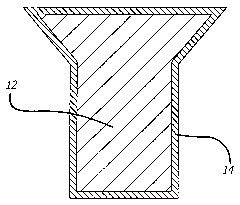Une partie des informations de ce site Web a été fournie par des sources externes. Le gouvernement du Canada n'assume aucune responsabilité concernant la précision, l'actualité ou la fiabilité des informations fournies par les sources externes. Les utilisateurs qui désirent employer cette information devraient consulter directement la source des informations. Le contenu fourni par les sources externes n'est pas assujetti aux exigences sur les langues officielles, la protection des renseignements personnels et l'accessibilité.
L'apparition de différences dans le texte et l'image des Revendications et de l'Abrégé dépend du moment auquel le document est publié. Les textes des Revendications et de l'Abrégé sont affichés :
| (12) Demande de brevet: | (11) CA 2550444 |
|---|---|
| (54) Titre français: | RIVET AMELIORE ET TECHNIQUE DE REVETEMENT |
| (54) Titre anglais: | IMPROVED RIVET AND COATING TECHNIQUE |
| Statut: | Réputée abandonnée et au-delà du délai pour le rétablissement - en attente de la réponse à l’avis de communication rejetée |
| (51) Classification internationale des brevets (CIB): |
|
|---|---|
| (72) Inventeurs : |
|
| (73) Titulaires : |
|
| (71) Demandeurs : |
|
| (74) Agent: | SMART & BIGGAR LP |
| (74) Co-agent: | |
| (45) Délivré: | |
| (86) Date de dépôt PCT: | 2004-11-18 |
| (87) Mise à la disponibilité du public: | 2005-07-07 |
| Licence disponible: | S.O. |
| Cédé au domaine public: | S.O. |
| (25) Langue des documents déposés: | Anglais |
| Traité de coopération en matière de brevets (PCT): | Oui |
|---|---|
| (86) Numéro de la demande PCT: | PCT/US2004/039125 |
| (87) Numéro de publication internationale PCT: | WO 2005060497 |
| (85) Entrée nationale: | 2006-06-16 |
| (30) Données de priorité de la demande: | ||||||
|---|---|---|---|---|---|---|
|
L'invention concerne un rivet en alliage d'aluminium traité thermiquement au préalable, qui est sablé avec de l'oxyde d'aluminium, puis lavé avec une solution résistant à la corrosion, séché, avant application d'un revêtement audit rivet. Le revêtement comprend un solvant, une résine, un plastifiant et un inhibiteur de corrosion. Le revêtement est cuit à une température élevée inférieure à 300 ·F, de préférence de l'ordre de 250 ·F, pendant approximativement une heure, ou entre une demi-heure et une heure et demie. Le rivet qui en résulte présente un revêtement de type garniture relativement épaisse, de l'ordre d'approximativement 0,0007 à approximativement 0,001 ou 0,002 pouce d'épaisseur, et conserve sa résistance élevée au cisaillement, résultant du traitement thermique de prérevêtement initial. Un autre traitement préalable consiste à anodiser les rivets à l'acide chromique.
A previously heat treated aluminum alloy rivet is sand blasted with aluminum
oxide, washed with a corrosion resistant solution, dried, and then a coating
is applied to the rivet. The coating includes solvent, resin, plasticizer and
a corrosion inhibitor. The coating is cured at an elevated temperature below
300~F, preferably in the order of 250~F for about an hour, or between one-half
and one and one-half hours. The resultant rivet has a relative thick gasket-
like coating about 0.0007 to about 0.001 or 0.002 inch thick, and retains its
high shear strength resulting from the initial pre-coating heat treatment. As
an alternative pre-treatment, the rivets may be chromic acid anodized.
Note : Les revendications sont présentées dans la langue officielle dans laquelle elles ont été soumises.
Note : Les descriptions sont présentées dans la langue officielle dans laquelle elles ont été soumises.

2024-08-01 : Dans le cadre de la transition vers les Brevets de nouvelle génération (BNG), la base de données sur les brevets canadiens (BDBC) contient désormais un Historique d'événement plus détaillé, qui reproduit le Journal des événements de notre nouvelle solution interne.
Veuillez noter que les événements débutant par « Inactive : » se réfèrent à des événements qui ne sont plus utilisés dans notre nouvelle solution interne.
Pour une meilleure compréhension de l'état de la demande ou brevet qui figure sur cette page, la rubrique Mise en garde , et les descriptions de Brevet , Historique d'événement , Taxes périodiques et Historique des paiements devraient être consultées.
| Description | Date |
|---|---|
| Le délai pour l'annulation est expiré | 2008-11-18 |
| Demande non rétablie avant l'échéance | 2008-11-18 |
| Réputée abandonnée - omission de répondre à un avis sur les taxes pour le maintien en état | 2007-11-19 |
| Inactive : Page couverture publiée | 2006-09-01 |
| Lettre envoyée | 2006-08-24 |
| Inactive : Notice - Entrée phase nat. - Pas de RE | 2006-08-24 |
| Demande reçue - PCT | 2006-07-24 |
| Exigences pour l'entrée dans la phase nationale - jugée conforme | 2006-06-16 |
| Demande publiée (accessible au public) | 2005-07-07 |
| Date d'abandonnement | Raison | Date de rétablissement |
|---|---|---|
| 2007-11-19 |
Le dernier paiement a été reçu le 2006-11-03
Avis : Si le paiement en totalité n'a pas été reçu au plus tard à la date indiquée, une taxe supplémentaire peut être imposée, soit une des taxes suivantes :
Veuillez vous référer à la page web des taxes sur les brevets de l'OPIC pour voir tous les montants actuels des taxes.
| Type de taxes | Anniversaire | Échéance | Date payée |
|---|---|---|---|
| Taxe nationale de base - générale | 2006-06-16 | ||
| Enregistrement d'un document | 2006-06-16 | ||
| TM (demande, 2e anniv.) - générale | 02 | 2006-11-20 | 2006-11-03 |
Les titulaires actuels et antérieures au dossier sont affichés en ordre alphabétique.
| Titulaires actuels au dossier |
|---|
| INNOVATIVE COATINGS TECHNOLOGY CORPORATION |
| Titulaires antérieures au dossier |
|---|
| ROBERT E. BRILEY |